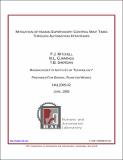| dc.description.abstract | The application of network centric operations principles to human supervisory control
(HSC) domains means that humans are increasingly being asked to manage multiple
simultaneous HSC processes. However, increases in the number of available information
sources, volume of information and operational tempo, all which place higher
cognitive demands on operators, could become constraints limiting the success of network
centric processes. In time-pressured scenarios typical of networked command
and control scenarios, efficiently allocating attention between a set of dynamic tasks
is crucial for mission success. Inefficient attention allocation leads to system wait
times, which could eventually lead to critical events such as missed times on targets
and degraded overall mission success. One potential solution to mitigating wait times
is the introduction of automated decision support in order to relieve operator workload.
However, it is not obvious what automated decision support is appropriate, as
higher levels of automation may result in a situation awareness decrement and other
problems typically associated with excessive automation such as automation bias.
To assess the impact of increasing levels of automation on human and system performance
in a time-critical HSC multiple task management context, an experiment
was run in which an operator simultaneously managed four highly autonomous unmanned
aerial vehicles (UAVs) executing an air tasking order, with the overall goal
of destroying a pre-determined set of targets within a limited time period. Four increasing
levels automated decision support were investigated as well as high and low
operational replanning tempos. The highest level of automation, management-byexception,
had the best performance across several metrics but had a greater number
of catastrophic events during which a UAV erroneously destroyed a friendly target.
Contrary to expectations, the collaborative level of decision support, which provided
predictions for possible periods of task overload as well as possible courses of action
to relieve the high workload, produced the worst performance. This is attributable
to an unintended consequence of the automation where the graphical visualization of
the computer’s predictions caused users to try to globally optimize the schedules for
all UAVs instead of locally optimizing schedules in the immediate future, resulting in
them being overwhelmed. Total system wait time across both experimental factors
was dominated by wait time caused by lack of situation awareness, which is difficult
to eliminate, implying that there will be a clear upper limit on the number of vehicles
that any one person can supervise because of the need to stay cognitively aware of
unfolding events. | en |
